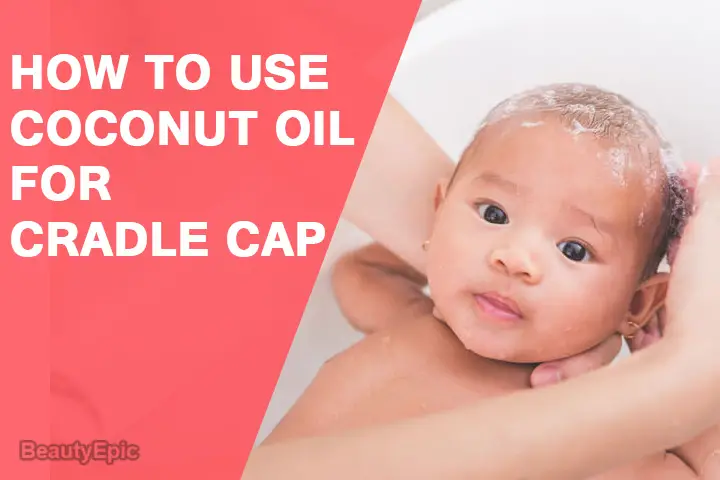
Important: This article is for informational purposes only. Please read our full disclaimer for more details.
Cradle cap is common yellowish patchy, greasy rashes on head of babies. Nobody exactly knows what causes Cradle cap in new born babies. Cradle cap is however not itchy or bothering to baby, but treating it is quite important. Coconut oil is a natural and effective way to treat the same. Let us read to know how to use coconut oil for cradle cap.
Does Coconut oil Work for Cradle Cap?
- Coconut oil has a number of benefits on skin due to its wonderful properties. Coconut oil, apart from being a cooking oil serves much more of uses.
- It has antimicrobial properties which cures any skin problem, including the cradle cap.
- Also, the skin of babies are fragile and soft, and using coconut oil is always advised.
- Not just as a cradle cap treatment, a regular usage of coconut oil helps lowering the possibility of skin infections.
How to Use Coconut oil for Cradle Cap
There are two popular ways by which you can use coconut oil for cradle cap, they are below. However, you can also use coconut oil alone for the same.
1. Coconut oil and Tea Tree oil for Cradle Cap
Like Coconut oil, tea tree oil is also antibacterial and anti-fungal in nature thus the mixture works well for cradle cap.
Ingredients:
- Tea tree oil
- Coconut oil
Preparation time: 2-3 minutes.
Procedure:
- Take tea tree oil and mix coconut oil in it. Remember since tea tree oil is very strong to babies the ratio should be 1:10
- Mix the ingredients gently.
How to use:
- Apply the mixture on the cradle cap affected area.
- Let it there for around 15 minutes
- Now remove the scales with the help of a soft toothed comb.
- After few minutes, wash the baby’s head.
How it works: Both the ingredients of the mixture are antibacterial and anti-fungal, thus they heal the skin.
Tips: Since tea tree oil is strong, the amount of it should not be more than the above mentioned one.
[ Read: How to Treat Baldness Using Castor oil ]
2. Coconut oil and Baking Soda for Cradle Cap
Well, Baking soda is a common household stuff. Both coconut oil and Baking Soda are pretty good for skin. Here is how you can you them for cradle cap.
Ingredients:
- Baking soda
- Coconut oil
Preparation time: 3-5 minutes.
Procedure:
- Mix few drops of Coconut oil and baking soda together.
- After mixing, apply the same on the affected area
- Wait for 20 minutes before removing the scales using soft toothed comb.
How it works: Baking soda is also used in shampoo-based cradle cap treatment. The mixture works well for the same.
Tip: Do not use hard toothed comb.
What Kind of Coconut oil is Good for Cradle Cap?
- Coconut oil is great approach for numerous skin issues.
- Organic and unrefined coconut oil is good for cradle cap and other skin problems because it contains all the natural and essential nutrients which heals the skin, including phytonutrients and polyphenols.
- Thus it is advised and recommended to use organic and unrefined coconut oil for cradle cap.
Coconut oil is considered as the very first thing to use in skin issues, same goes with cradle cap. The oil is the most popular remedy for cradle cap. Apart from it, coconut oil has other benefits for skin also. Cradle cap are usually considered harmless but treating it at early stage is advised and coconut oil is effective in that.
You Might Also Like:
- Is Coconut Oil Safe For Babies To Eat
- How To Get Baby Oil Out of Hair
- DIY Coconut oil Face Serum
- Benefits and Uses of Coconut oil
- 14 Surprising Beauty Benefits of Baking Soda You Must Know!
- Coconut Oil For Acid Reflux
- How to Use Coconut Oil for Constipation?
- How to Remove Dandruff With Coconut oil?
- Coconut Oil for Diaper Rash: Does It Work and How to Use?
- How to Use Coconut oil for Dry Hair Treatment?
- Does Coconut Oil Work for Hemorrhoids?
- Coconut Oil For Jock Itch
- Does Coconut oil Help with Scars And How To Use It?
- How to Use Coconut Oil to Remove Your Stretch Marks?
- How To Use Coconut Oil For Sunburn Relief?
- How To Use Coconut Oil For Oil Pulling
- Can You Use Coconut oil After Lash Lift?
- Difference Between Coconut Oil And Coconut Butter
Image:- 1
















